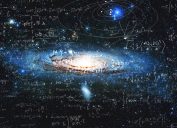
"Twinkle, twinkle, little star." Though it's ostensibly just a quaint nursery rhyme, the Jane Taylor poem we all know by heart is so much more. Yes, it's a lullaby. Yes, it's an introductory language tool. But for many children, it's also the first taste of space and science—and the idea that there might be more to life than meets the eye.
Here's the thing, though: That little ditty is wrong. Stars don't actually twinkle.
Huh?
That's right: the faint change in brightness and color—the unmistakable glimmer stars give off on a clear night—is all due to the atmosphere, and how it affects human perception. Specifically, the tumult of the earth's atmosphere is responsible for the shifts in light that we interpret as stars twinkling. In astronomical terms, such blurring and scintillating is referred to as "astronomical seeing." As the atmosphere churns (think of it like boiling water, mixing and moving in different directions), the light from the stars is refracted in different directions. Then, the light changes slightly in brightness and position, resulting in that famous twinkle.
So, no, it's not entirely an optical illusion; we really are witnessing a shift in light and position. But the star itself isn't changing—it's just a result of the lens through which we see it: the atmosphere.
As you may know, our planet's atmosphere is divided into five layers: the troposphere (where we live), the stratosphere, the mesosphere, the thermosphere, and, finally, the exosphere (where satellites live). It's that base layer, the troposphere—specifically, the planetary boundary layer, the closest part to the ground—that's responsible for turbulence, which mucks things up. (On another note, turbulence is part of the reason why golf balls fly through the air in the way they do; it's also because of their uniquely dimpled shape.)
To put it simply, the sun warms the gases of the atmosphere unevenly, creating convection currents and circular wind patterns as air moves between high- and low-pressure areas. Turbulence redistributes and mixes heat, moisture, pollutants, and everything else that makes up the atmosphere. This excitable layer is where all weather occurs, and its turbulence is responsible for the astronomical seeing, which makes accurate earth-based astronomy difficult. In fact, of all the roadblocks facing astronomy today—budget cuts, staffing shortages, the simple and undeniable fact that technology just isn't there yet—turbulence is among the biggest.
Powerful space telescopes like the Hubble are able see the stars exactly as they are, without any pesky atmospheric interference. (There's no atmosphere in space). High-altitude observatories—like those at Mauna Kea, Hawaii, or La Palma, in the Canary Islands—also enjoy better visibility, because there's less air between the lens and the stars. Chile is also a popular spot for observatories, because colder temperatures produce more ideal stargazing conditions, as well; warm air tends to be more turbulent, so colder is clearer. Other than that, though, space observation is sure to run into the turbulence problem from time to time. And for more fascinating facts from the great beyond, check out these 21 Mysteries About Space No One Can Explain.
To discover more amazing secrets about living your best life, click here to follow us on Instagram!





















